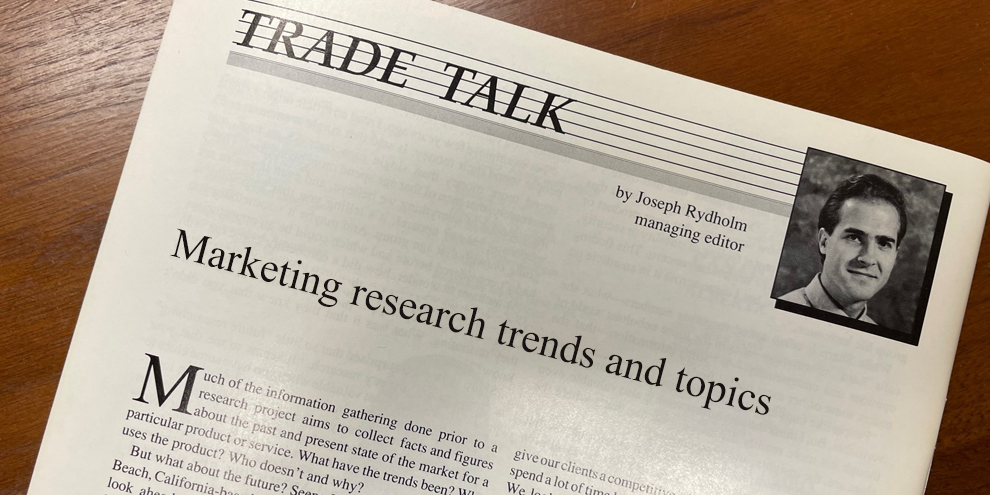It's a long time from late May to September (to loosely paraphrase the old song), but that's how long it took our staff to compile and produce the first annual QMRR Researcher SourceBook, which most of you received last month. During the coming year, we hope the SourceBook makes your job a little easier by helping you find the people who provide the research products and services you need.
Though the SourceBook contains thousands of listings, I'm sure that some firms were overlooked. So as part of our regular January, 1991 issue we're going to publish a supplement to the SourceBook, to list firms we missed and to correct any errors we might have made. If you work for or are a client of a firm that didn't get listed, please give us a call or send us a note with the firm's name and address. Using this information, we'll send out new listing forms for the supplement.
And if you have any suggestions on how we can make next year's SourceBook more useful to you, please let us know.
* * *
With that out of the way, let's look at REACT, a new information gathering system for retailers that uses a customer's phone number to track a variety of purchase-related variables, allowing retailers to target their marketing efforts to each customer's specific needs and interests.
The system is the creation of Tom Noether and Peter Polumbaum, principals of Retail Consumer Technology, East Windsor, Conn. Both spent several years with United States Shoe Corp., and during that time, Noether says, they became frustrated by their inability to get close to the customer.
"We were familiar with the needs of the retail community in the 90s. We knew that retailers, to succeed, had to find ways to increase store productivity. And we knew that the best way for retailers to do that was to build their business with their existing customer base. The problem was, how do you get enough information about your customers to effectively communicate with them and build business with them?
"Peter and I reasoned that there must be a way to get demographic, geographic, and purchase data on every customer - but we found that nothing like that existed. Some try to capture that data in-store, but it's much less meaningful, be-cause it's so sporadic - and it's a real hassle to customers."
Create their own
After fruitless talks with various mapping and customer profiling firms about developing such a system, they decided to create their own. Their goal was to make a system that would be easy for both retailers and customers to use. Centering the system on the customer's phone number met that goal because it adds only a few seconds to the purchase process for the salesperson key the customer's number in.
The system matches the phone number with specific demographic information that becomes part of each customer's file, along with the data on their purchasing habits, which is updated monthly with each new transaction tape.
"By providing our clients with a list of attributes - for example, product class bought, frequency of purchase, dollar amount, payment method - we help them forge a personal relationship with their customers. You become, for lack of a better term, friends with them, so that when you choose to communicate, you can talk about things that are relevant to that customer."
Direct marketing
This communication includes direct marketing efforts geared towards each customer's interests, such as mailings on upcoming sales, new arrivals, or fashion shows, for example. "Your junk mail becomes like a letter to a friend because you're providing a service," Noether says.
"The key to the system from our perspective is that the customer is being invited onto a mailing list. The retailer is saying to them, By making a purchase here, you've made a commitment. We know you like us a little. For us to serve you best, we need to know more about you. So we ask you for your phone number because that's our way of putting you on the mailing list.' "
Honest with customer
Noether says he stresses to his clients that they must be honest with the customer about their intentions.
"We tell all of our clients that they have to be up front with their customers about why they want the phone number. This includes providing some kind of point of sale sign or a card that they could hand to a customer who wants a detailed explanation of why they're on the system. Because if the retailer uses REACT as a way of faking a customer into being on a mailing list, that's a real problem. If the customer doesn't want to be on the mailing list, all they have to do is say so."
Currently, over 1,300 of U.S. Shoe Corp.'s Casual Corner, Petite Sophisticate, Caren Charles, and August Max Woman stores are using the system. Noether says along with the strategic value that comes out of knowing who your customer is, the system can also be useful for marketing research projects, such as recruiting for panels of various types of customers, from regular to infrequent.
But, he says, "the overriding use is to allow retailers to take their occasional customer and turn them into a great one and to take their great customer and preserve them."
